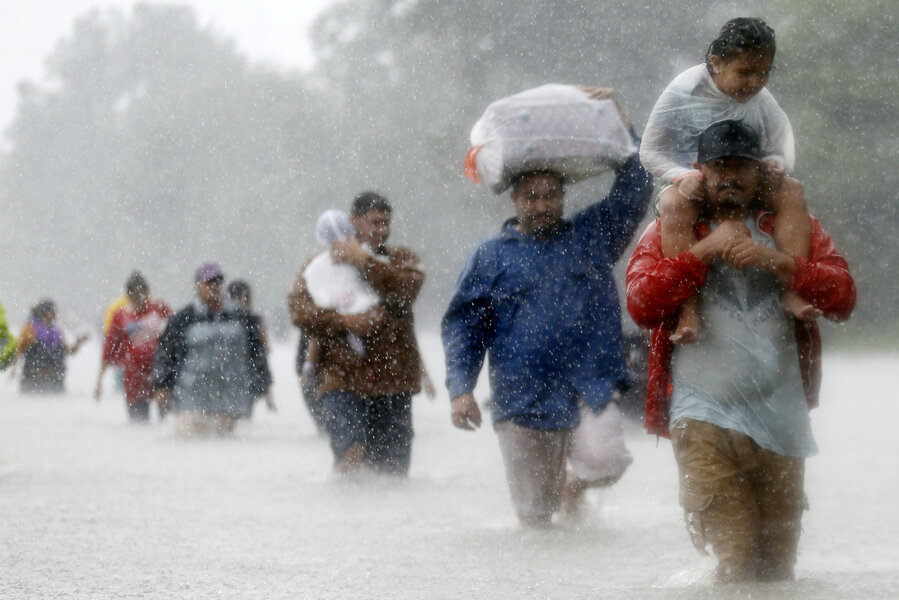Natural disasters: 2017 costliest year
Loading...
2017 was the most expensive on record for US natural disasters, according to a January report from the National Oceanic and Atmospheric Administration (NOAA). In total, they cost the United States an estimated $306 billion.
What factors made 2017 so expensive?
Americans saw a slew of unusually powerful weather events in 2017, with three major hurricanes – Harvey, Irma, and Maria – ranking in the top five costliest natural disasters since 1980. While damage to residences represented the biggest expense, industry sustained unusually significant blows. Tourism, an economic cornerstone in the Florida Keys and many Caribbean islands, was stalled by the violent weather, and pharmaceutical manufacturing capacity in Puerto Rico was decimated by hurricane Maria. Energy production in Texas was also sharply cut in the days following hurricane Harvey’s record rains.
People were especially susceptible to last year’s natural disasters, says Susan Cutter, director of the Hazards and Vulnerability Research Institute at the University of South Carolina in Columbia. Several of the disasters – including hurricanes on the Gulf Coast and wildfires in California – hit urban centers. “The impacts are based on the exposure of populations,” she says. “Many of these events did not affect low-
density areas.”
How does the US estimate the cost of a natural disaster?
To form its estimate, NOAA draws data from public and private sources such as the Insurance Services Office, the Federal Emergency Management Agency, and the US Department of Agriculture. But the calculations can be messy. For one thing, the effects of a disaster are wide-ranging – everything from the destruction of houses to the lost revenue from business shutdowns. Also, many damaged assets from last year were uninsured. To correct for such gaps, NOAA scales up the data for insured losses, but it acknowledges that some costs, such as health-care related losses or values associated with loss of life, aren’t fully accounted for.
Why did some places seem ill-prepared?
“We have to make better decisions on where we allow development to occur,” says Kevin Simmons, an economics professor at Austin College in Sherman, Texas. In the US, Professor Simmons notes, tough questions about disaster preparedness rarely arise when new construction begins. Flood experts argued that in Houston, for example, the increasingly paved urban landscape prevented the ground from absorbing floodwaters.
As Professor Cutter sees it, the problem is an economic disconnect. Development in vulnerable regions is typically driven by local communities that benefit from larger tax bases and more economic activity. But when disaster strikes, it’s the federal government that often covers the damages. Local governments aren’t always held responsible for paying for the damages that risky development can cause.
Are large-scale natural disasters becoming the new normal?
“There are certain weather and climate hazards that we are seeing more often, and more severely when they see them,” says Deke Arndt, chief of the climate monitoring branch for NOAA’s National Centers for Environmental Information. He cites increases in heat, rain, flooding, and drought.
But the relationship between climate and weather is complicated. Harsher droughts and heavier floods can lead to more extreme weather, but they don’t necessarily guarantee more disasters in the near future, according to Mr. Arndt.
In other words, think of weather as a boxer, and climate as a trainer. “Weather still throws the punches, but climate trains the boxer. And as climate changes, as you change that trainer, the boxer will throw certain punches more often and effectively,” he says.
How can communities successfully plan for future destructive events?
Experts point to a few cities with important lessons for staying safe in an uncertain future.
Tulsa, Okla., sits just above the turbulent Arkansas River, and for years it experienced devastating flooding whenever the river swelled. Three decades ago, the city decided to act. City planners built multiuse drainage basins, relocated the most vulnerable riverside residents, and imposed strict flood-minded zoning requirements for developers. The result has been fewer flooding events in the Great Plains city, says Cutter, and a stronger resolve for sustainable development.
New York City also has a new approach, after responding to superstorm Sandy in 2012 – the Rebuild by Design initiative. The program allocates federal funding to community-based solutions that emphasize disaster preparedness. Projects that New York has undertaken include transit repairs and shelters for disabled residents who can’t evacuate. The program has become a model that other cities are now following.
The most important step in achieving a sustainable recovery, says Simmons of Austin College, is generating local support. And now may be the best time to do so. “Anytime an event occurs, you have a window of opportunity when you’ve got people’s attention,” he says.







